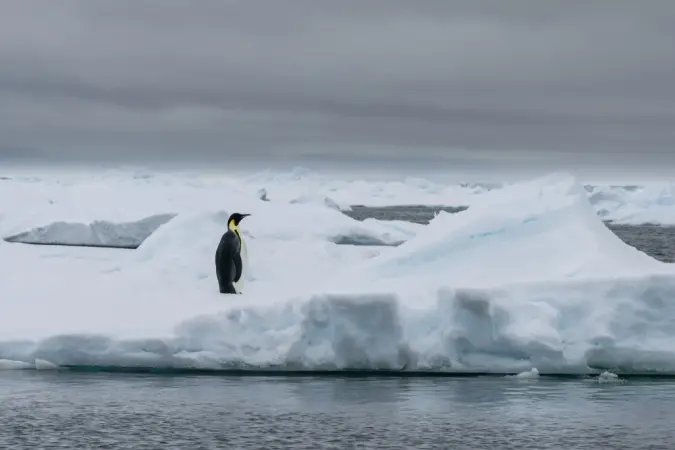Emperor Penguin Numbers Plunge 22% as Antarctic Sea Ice Vanishes Amid Climate Change, New Satellite Study Shows
The emperor penguin population in Antarctica is facing a more dramatic decline than previously estimated, with a new satellite analysis revealing a 22% drop in 16 key colonies over the past 15 years. The main driver behind this alarming trend is climate change, which is rapidly shrinking the sea ice critical to the species’ survival. Conducted between 2009 and 2024, the study highlights the growing threat global warming poses to one of Antarctica’s most iconic and vulnerable species.
According to the British Antarctic Survey, which analyzed high-resolution satellite images, emperor penguins depend heavily on stable sea ice to breed, nest, and forage. These flightless birds rely on solid ice platforms from April to December to raise their chicks. However, as ocean temperatures rise and weather patterns shift, the ice forms later and melts earlier, disrupting the penguins' reproductive cycle.
“This level of decline is deeply concerning,” said Peter Fretwell, a researcher with the British Antarctic Survey and co-author of the study. “Emperor penguins need sea ice for virtually every part of their life cycle. Without it, they face severe risks of breeding failure, predation, and reduced food access.”
The 16 colonies included in the study are spread across the Antarctic Peninsula, Weddell Sea, and Bellingshausen Sea—regions that have experienced some of the continent's most rapid climate shifts. These colonies represent about 30% of the global emperor penguin population, which is found exclusively in Antarctica.
While previous estimates suggested a roughly 10% population decline continent-wide over the past 15 years, this updated analysis paints a much bleaker picture for parts of the population. Scientists are still unsure whether similar declines are happening in other regions, but the findings suggest the potential for more widespread population stress.
Sea Ice Loss Threatens Penguin Habitat and Increases Predation
Emperor penguins rely on land-fast sea ice—ice that is attached to the shoreline or grounded icebergs—not only for breeding but also for molting and launching their foraging trips into the Southern Ocean. As the ice deteriorates, it exposes chicks to drowning risks and adult penguins to longer, more dangerous food hunts.
Moreover, as sea ice retreats earlier in the season, predators like leopard seals and orcas are gaining unprecedented access to breeding colonies. This added predation pressure further undermines chick survival rates, compounding the effects of environmental stress.
“In some regions, the sea ice is breaking up before the chicks have developed waterproof feathers, leading to mass mortality,” said Daniel Zitterbart, a marine biologist at the Woods Hole Oceanographic Institution, who reviewed the study. “It’s absolutely alarming that the situation is deteriorating faster than models predicted.”
Climate Change’s Broader Impact on Antarctic Ecosystems
The loss of emperor penguins is not an isolated phenomenon—it’s indicative of the cascading effects climate change is having on the Antarctic ecosystem. As ocean temperatures rise, the availability of krill, a major food source for penguins, seals, and whales, also declines. Changes in sea ice conditions can disrupt the entire food chain, destabilizing marine biodiversity in the Southern Ocean.
Rising global temperatures, increasing atmospheric CO₂ levels, and shifting precipitation patterns are contributing to widespread habitat loss for Antarctic wildlife. In 2023, researchers observed record-low sea ice extent across the continent, raising urgent questions about the resilience of cold-adapted species like emperor penguins.
The study’s authors warn that without aggressive global climate action—especially rapid reductions in fossil fuel emissions—emperor penguins may be on a path toward extinction. In fact, in 2022, the U.S. Fish and Wildlife Service officially listed emperor penguins as a threatened species under the Endangered Species Act due to climate-related risks.
Looking Ahead: Urgency for Conservation and Climate Policy
The emperor penguin’s fate is increasingly seen as a barometer for the health of the Antarctic environment. As satellite monitoring becomes more sophisticated, scientists will be better equipped to track changes in population size and distribution. However, experts emphasize that mitigation efforts—like international climate agreements, marine protected areas, and emissions reductions—are urgently needed to preserve the species.
“If we continue on our current emissions trajectory, more than 90% of emperor penguin colonies could be quasi-extinct by the end of the century,” said Fretwell. “These animals have evolved over millennia to thrive in extreme conditions, but even they cannot keep pace with the rapid environmental changes we are seeing today.”
The time to act is now. Protecting emperor penguins is not only about saving a species—it’s about preserving the ecological integrity of one of the planet’s last great wildernesses.

